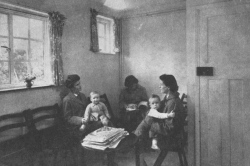A Healthy Start - General Practice
When free healthcare was introduced in 1948 a huge backlog of ‘hidden’ medical conditions was unleashed that took years to clear. What had previously been a cottage industry has grown over the past 60 years to become an important business requiring management skills as well as medical ones.
 Image left: A typical GP's home surgery in the 1940s - the living room becomes the waiting area. Courtesy of the Royal College of General Practitioners
Image left: A typical GP's home surgery in the 1940s - the living room becomes the waiting area. Courtesy of the Royal College of General Practitioners
When the NHS began, most GPs continued to work from home and retained their independent contractor status rather than becoming salaried employees of the government. This unfortunately meant working in isolation from other health services, something that only began to change in the late 1960s when emphasis shifted to purpose-built premises, encompassing clerical, nursing and social work staff.
GPs were free to prescribe what they chose but anything expensive had to be justified to the Local Medical Committee (made up of their peers). This became increasingly common with the rising costs of medication and GPs were encouraged to prescribe generic rather than ‘brand name’ drugs.
In 1952 a prescription charge of one shilling (five pence) per item was introduced. 1965 saw the charge abolished only to be re-introduced in 1968. From there charges rose steadily, until the Scottish National Party made their abolition a feature of their 2007 election campaign. The Scottish Government have since pledged to scrap prescription charges by 2011.